-
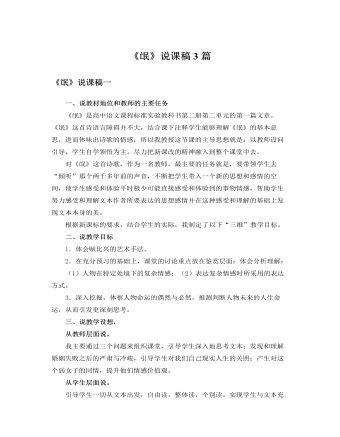
人教版高中语文必修2《氓》说课稿3篇
四、教学方法和学法。课前学生搜集有关《诗经》的资料必不可少。另外,时隔数千年,年代久远,文字的障碍很大,然而,过分纠缠于文字的疏通会破坏诗歌的“气”,丧失诗歌的“神”,所以在学习时,应舍去条分缕析的理论评价,指导学生结合注释疏通文字,然后引领他们经由文字再现形象和事件,经由形象和事件领略情感,感受其中浓浓的诗情。诵读的环节是重要的,配以二胡独奏《长相思》,营造意境,学生沉浸在音乐营造的意境中反复吟咏,读出节奏,读出音调,读出感情,细细体味,让或优或喜的情愫萦绕心间,我们就触到了先民的灵魂。比兴手法为《诗经》独创,重章叠句同样别致而新鲜,教学过程中结合具体语境让学生自己去发现并进行讨论,不搞枯燥的知识传授。还引入讲故事、改写两种活泼的学习形式,从而达到加深理解的目的。
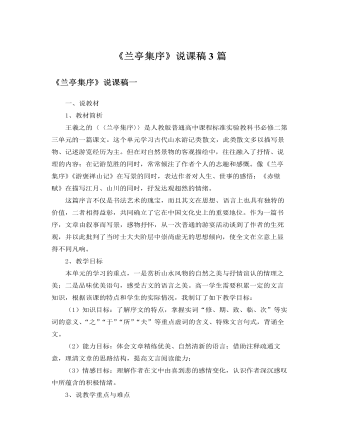
人教版高中语文必修2《兰亭集序》说课稿3篇
(二)分析课文,理清思路第1、2段为第一部分,主要是叙事、写景,先叙述集会的时间、地点,然后渲染出兰亭优美的自然环境。在这里足以“游目骋怀”“极视听之娱”,可以自由地观察、思考,满足人们目视耳闻的需求。这里正是与会“畅叙幽情”、尽兴尽欢的绝好处所。这些描写都富有诗情画意,作者的情感是轻松愉快的。第3、4段为第二部分,主要是抒情、议论,作者由美景妙时引发出乐与忧、生与死的感慨。他认为人生的快乐是有极限的,待快乐得到满足时,就会感觉兴味索然。往事转眼间便成为历史,人到了生命的尽头就会死亡。作者由“一死生为虚诞,齐彭殇为妄作”的认识,产生了一种珍惜时间、眷恋生活、热爱文明的思考。虽然文中的寿夭、生死不能自由决定,从而有些伤感,但作者仍然认识到盛衰、生死是必然的。人生无常,时不我待,故著文留传后世,以承袭前人,启示来者。
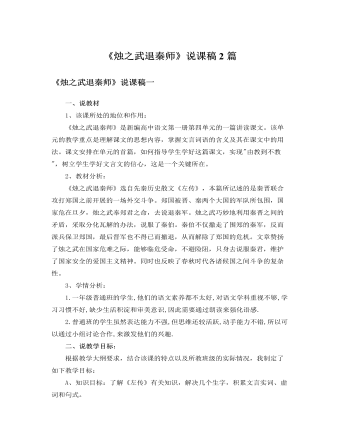
人教版高中语文必修1《烛之武退秦师》说课稿2篇
4、本文的重点是说辞,虽仅百余字,却委婉曲折,步步进逼,层层深入,表现出高超的劝说艺术、游说技巧。让学生细细品味并概括说辞中包含几层意思。第一层(“秦、晋围郑,郑既知亡矣”),分析形势,以退为进,博得好感。第二层(“若亡郑而有益于君”至“君之薄也”),亡郑陪邻,动摇联盟。第三层(“若舍郑以为东道主”至“君亦无所害”),存郑有益,利益引诱。第四层(“且君尝为晋君赐矣”至“唯君图之”),追溯历史,深入离间。可见烛之武面对大国的君主,巧舌如簧,不卑不亢,从容辞令,既不刺激对方也不失本国尊严,语言的分寸掌握得恰到好处。表现出烛之武机智善辩的外交才能。5、面对风云突变的局势,晋侯没有感情用事,而表现了清醒的头脑和理智的判断。这种隐忍不发、随机应变的胸怀和谋略,正是晋文公终成霸业的根本原因。设计意图:本环节的重点是全面把握烛之武这一人物性格特征,以及退秦师过程中体现出的非凡的胆识以及高超的谋略和语言艺术。
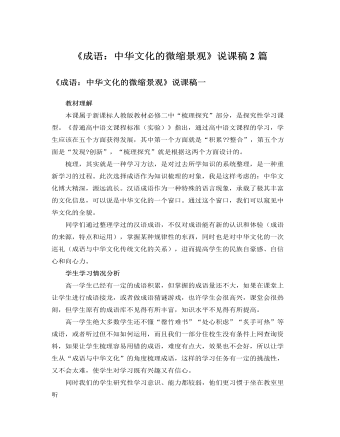
人教版高中语文必修2《赤壁赋》说课稿3篇
[教学反思]人教版高中语文必修二第三单元安排了《兰亭集序》《赤壁赋》《游褒禅山记》三篇古代山水游记散文,它们借游赏之事,探索生命的意义、治学的道理。师者,所以传道、授业、解惑也。高中的教材选用的都是历史经典名篇,每一篇都闪烁着儒道释等百家光辉的思想。编者要老师传道的意图很明显。即非如此,看着这些影响历代、影响世界的如日月之耀眼光华的伟大思想就躺在我们的教科书里,又如何能不讲呢?所以,我将本课的教学重难点拟定为:帮助学生建立积极的生死观,掌握多角度看问题的正确的思想方法。当然,也让学生领会了融写景、抒情、说理于一炉的大家手法。整堂课各教学环节,环环相扣,过渡自然,读、思、议、写训练到位,而且全部围绕“生死观”展开,如一篇形散神不散的散文。
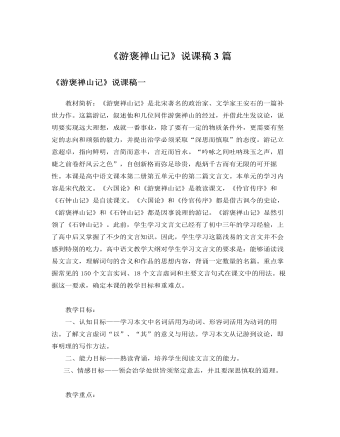
人教版高中语文必修2《游褒禅山记》说课稿3篇
学法指导:高一学生对文言文阅读已具备了一些基础知识和积累,但对如何学习文言文,还是一个新课题,因此教师应引导学生掌握学习方法,运用已有的知识框架同化新信息,建立新的智能,逐步走向独立学习的境界。一、引导学生利用课文注释,使用工具书自己翻译,必要时教师进行点拨、解难,培养自学能力。二、告诉学生翻译文言文要遵循的原则。三、调动学生思考、讨论、交流的积极性,教师适时点拨,培养学生发现问题、解决问题的能力。四、提示学生反复诵读课文,体会文章所阐述的道理。五、鼓励学生及时归纳学习文言文的方法,注意积累文言文知识。教学程序:教学本课可安排2课时。第一课时:1、导入新课:首先给学生介绍毛泽东的七绝诗《为李进同志题所摄庐山仙人洞照》:“暮色苍茫看劲松,乱云飞渡仍从容。天生一个仙人洞,无限风光在险峰。”学生通过诵读领会了“无限风光在险峰”一句的含义。随后因势利导,引出课题,指出今天我们要学习的王安石的《游褒禅山记》,就含有类似的深邃哲理。
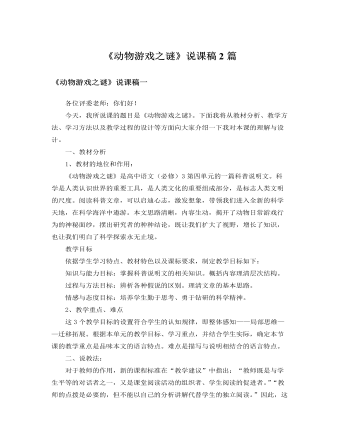
人教版高中语文必修3《动物游戏之谜》说课稿2篇
一、导入新课人类社会越来越现代化,新科学技术日新月异,令人目不暇接,称之到了“知识爆炸”的时代也毫不为过。由此而来的是生活的快节奏,学习和工作的竞争也越来越激烈。这种竞争一直波及到了儿童,加之中国几千年来形成的望子成龙的传统观念,使作父母的把一切希望都寄托在孩子身上,实现自己未能实现的理想。祖孙三代4、2、1的局面,使12只眼睛都盯在了孩子身上,真是走路怕摔着,吃饭怕噎着,干活怕累着,要星星不敢摘月亮,要吃什么跑遍全城也要买来。这种过分保护、溺爱及过早地灌输知识会得到什么结果呢?乐观者说孩子越来越聪明,越来越早熟,将来能更好适应现代化的要求;悲观者则认为豆芽菜式的孩子将来经不起风浪,小皇帝太多了很难凝聚成统一力量,将来谁去当兵,谁去干那些艰苦创业性工作……。对孩子本身来说,是幸福还是……在此不想多发议论,还是让我们来看看动物世界的孩子们吧,也许会得到某种启迪。
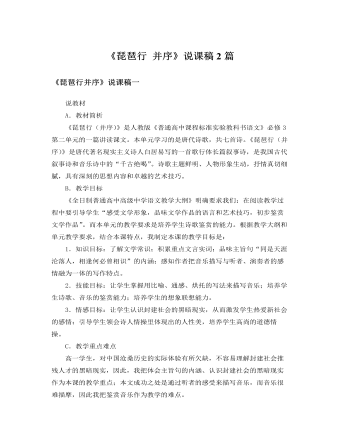
人教版高中语文必修3《琵琶行 并序》说课稿2篇
说教材A.教材简析《琵琶行(并序)》是人教版《普通高中课程标准实验教科书语文》必修3第二单元的一篇讲读课文。本单元学习的是唐代诗歌,共七首诗。《琵琶行(并序)》是唐代著名现实主义诗人白居易写的一首歌行体长篇叙事诗,是我国古代叙事诗和音乐诗中的“千古绝喝”。诗歌主题鲜明、人物形象生动,抒情真切细腻,具有深刻的思想内容和卓越的艺术技巧。B.教学目标《全日制普通高中高级中学语文教学大纲》明确要求我们:在阅读教学过程中要引导学生“感受文学形象,品味文学作品的语言和艺术技巧,初步鉴赏文学作品”。而本单元的教学要求是培养学生诗歌鉴赏的能力。根据教学大纲和单元教学要求,结合本课特点,我制定本课的教学目标是:1.知识目标:了解文学常识;积累重点文言实词;品味主旨句“同是天涯沦落人,相逢何必曾相识”的内涵;感知作者把音乐描写与听者、演奏者的感情融为一体的写作特点。
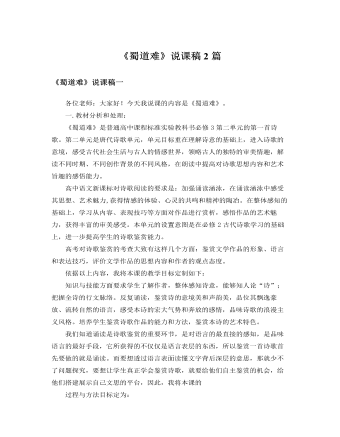
人教版高中语文必修3《蜀道难》说课稿2篇
(1)“问君西游何时还……使人听此凋朱颜。”诗题下未注明送何人入蜀,所以这里的“问君”无妨假定实有其人,可以读得亲切一些。将行而问“何时还”,已有不可行之意,重音要落在“不可攀”三字上,当用劝说的语气读。以下四句借鸟声渲染旅途中悲凉凄清的氛围,读时要放低声调,有干里孤身之感,至“愁空山”徐徐而上。然后用感喟的语调读主旨句,至“凋朱颜”略作一顿,以示意犹未尽。(2)“连峰去天不盈尺……胡为乎来哉!”仍是说不可行,但内容加深了一层,因为说的是蜀道的险恶。前四句不是纯客观的描写,读时须设想这是旅游者攀援于“连峰”“绝壁”之上置身于“飞湍瀑流”之间,要使听者感到惊心动魄。读后可作稍长停顿,再用“其险也如此”缓缓收住。末句是诗人借用蜀人的口气,对历险而来的游者深表叹息——“胡为乎来哉”不是询问,当用降调读,暗含“何苦而来”之意。
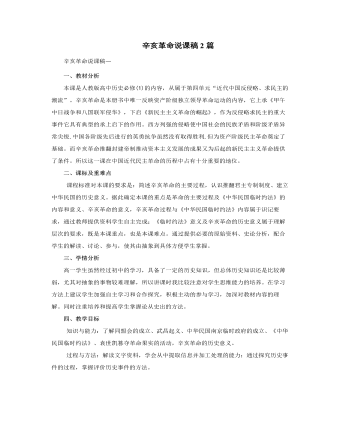
人教版高中历史必修1辛亥革命说课稿2篇
三、辛亥革命的结局1.袁世凯窃取革命果实由课件给出窃取革命果实的简单过程,帮学生理清思路,创设问题情境,由学生分析革命果实被窃取的原因,教师给以补充并揭示根本原因,贯穿整个革命的资产阶级的软弱性和妥协性,再次加深对难点的理解。2.历史功绩辛亥革命性质、功绩由学生阅读书本进行总结,再加以补充让学生在书本上做好记录,强调最大功绩是结束了两千多年的君主专制政体。辛亥革命的失败及其评价很易搞成生硬的一言堂形式,可以从多种角度把学生思维调动起来。这里采用列举一个合作探究,自由讨论的题目“有人认为辛亥革命因为没有完成反帝反封建的革命任务而失败,有人则认为辛亥革命是中国“从君主到民主”社会转型的成功开始。你同意哪种看法?”要求同学们自由讨论.各抒己见,大胆创新,言之在理即可.教师在一旁引导学生,活跃课堂气氛.最后教者归纳总结学习历史从不同的角度看问题可以得出不同的结论,学会用辩证的观点看待历史问题,对辛亥革命有个全面的认识。

人教版高中历史必修1鸦片战争说课稿2篇
“第二次鸦片战争”爆发的原因的讲析,可通过出示英国在鸦片战争后在中国与洪都拉斯的正当贸易对比表,让学生观察和创设情景来得出结论。战争的经过及影响,可以通过两次鸦片战争形势图,以及一张相关的表格,从战争的根本目的、性质、过程及影响等方面来比较两次战争的异同,从而让学生理解掌握“战火再燃”其实就是中英鸦片战争的继续和扩大。并理解“第二次鸦片战争”的如何使中国社会半殖民地半封建化的程度大大加深了。并突出英法两国殖民者在占领北京期间所犯的滔天罪行。3、结:结合板书设计,让生自己总结这节课所学的内容,并通过课后习题练于讲相结合,来巩固本课知识。在此基础上对本课线索及主要知识点进行简要的梳理。4、课题延伸:教材后探究学习总结中的一段材料,即《英国驻华商务监督义律致英国外交大臣巴麦尊的机密件》,让学生究义律对中国发动鸦片战争原因的说辞来展开探讨,启发学生运用辨证唯物主义的基本观点,澄清和批驳在在一问题上的一些错误和谬论,从而提高学生辨别是非的能力和批判的能力.

人教版高中历史必修2开辟新航路说课稿3篇
一、说教材《开辟新航路》是高中《历史·必修二》第5课的内容。从三个方面向学生介绍了欧洲人开辟新航路的历史:即新航路开辟的原因和条件、新航路开辟经过以及影响。前4课内容介绍了古代中国经济的基本结构与特点,从第5课开始学习资本主义世界市场的形成和发展。本课内容相当重要,上承古代中国,下启近代世界。新航路的开辟,打破了世界相对隔绝的状态,世界真正开始融合为一个整体。从此,以西欧为中心的世界市场的雏形开始出现。随后的殖民扩张,世界市场拓展;第一次工业革命,世界市场基本形成;第二次工业革命,世界市场发展。二、说目标1、课程标准概述迪亚士、哥伦布开辟新航路的史实,认识地理大发现对世界市场形成的意义。2、三维目标①知识与能力:掌握新航路开辟的原因、经过、影响。②过程与方法:引导学生分析原因及影响,培养学生分析和归纳问题的能力。③情感态度与价值观:A、通过对新航路开辟过程的学习,使学生感受和学习探险家们勇于进取的开拓精神。B、通过学习新航路开辟的影响,使学生认识新航路开辟促进了人类社会的整体发展。

人教版高中生物必修2伴性遗传说课稿
(1观察图解,色盲基因在性别间是如何传递的呢?(女--女、女--男、男--女)(2)为什么不能由男性传给男性?(色盲基因是在X染色体上,因此色盲基因是随X染色体的传递而传递。)(3)男性的色盲基因怎样才能传给男性呢?(通过女儿,传给外孙即交叉遗传)(4)从图解看色盲在男女中的发病情况怎样?(男性多于女性)(5)从社会调查也是这样,你是否能从基因和染色体的角度加以解释?(提示:女性染色体的构成,结合基因位置及显隐性进行分析)归纳特点:归纳出色盲基因遗传的特点并扩展到X染色体隐性遗传的特点上。色盲基因遗传(X隐性遗传)的特点:(1)男患者多于女患者(2)交叉遗传(3)女病儿子必病,男正女儿必正等。问题探讨:利用“遗传图解”结合“问题链”继续探讨,拓展到抗维生素D即X 染色体显性遗传的特点。(6)色盲基因在X染色体上属隐性基因,子代表现男多于女,对应的正常色觉基因则属于X显性基因,子代表现应如何?(女多于男)
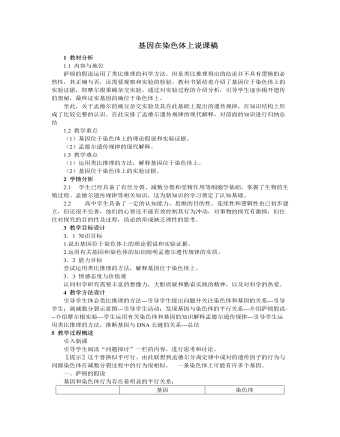
人教版高中生物必修2基因在染色体上说课稿
三、孟德尔遗传规律的现代解释①分离定律:在杂合体的细胞中,位于一对同源染色体上的等位基因,具有一定的独立性;在减数分裂形成配子的过程中,等位基因随同源染色体的分开而分离,独立地随配子遗传给后代。②自由组合定律:位于非同源染色体上的非等位基因的分离或组合是互不干扰的;在减数分裂过程中,同源染色体的等位基因彼此分离的同时,非同源染色体上的非等位基因自由组合。总结:再次强调孟德尔遗传定律的现代解释课堂练习:书本31页6、教学反思:本节课设置了一系列问题情境,层层设问,在学生答问、质疑、讨论过程中让学生建构新概念和新的知识体系,并通过教师及时掌握反馈信息,适时点拨、调节,让学生在推理判断中培养良好的思维习惯和对知识的迁移能力,而且通过留出一定的时间让学生提问,体现了以学生为主体的思想。
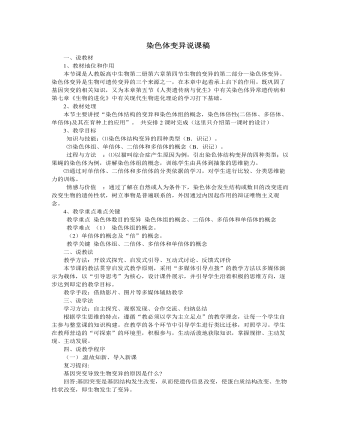
人教版高中生物必修2染色体变异说课稿
四、说教学程序(一).温故知新、导入新课复习提问:基因突变导致生物变异的原因是什么?回答:基因突变是基因结构发生改变,从而使遗传信息改变,使蛋白质结构改变、生物性状改变,即生物发生了变异。那么,基因是什么?它和染色体又有何关系?回答:基因是有遗传效应的DNA片断,染色体是DNA的载体,基因在染色体上呈线形排列。引出新知:对于一个生物体来说,正常情况下,其染色体的结构和数量都是稳定的。但在自然条件或人为因素的影响下,染色体的结构和数量均会发生改变,从而导致生物性状的改变,这就属于染色体变异。(二).把握重点、突破难点重点的把握:1、染色体结构的变异播放影片:猫叫综合征幼儿。让学生观察: 患儿哭声轻、音调高,很像猫叫。教师补充: 患儿的征状---两眼较低、耳位低下,存在着严重的智力障碍。阐述病因---染色体片段缺失
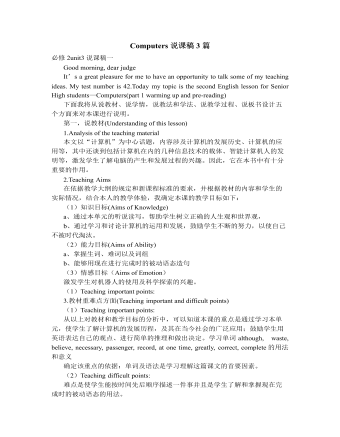
人教版高中英语必修2Computers说课稿3篇
一. 教材分析1. 本单元的中心话题是“计算机(Computers)”,内容涉及计算机的发展历史,计算机的应用等。本节课是该单元的第一课时,我将Warming up, Pre-reading and Comprehending这四部分整合为一节精读课。其中。Reading部分是题为WHO AM I?的文章,以第一人称的拟人手法介绍了计算机发长演变的历史和计算机在各个领域的应用,其主旨是表达计算机的发展变化之快以及在生活中用途之广。而Warming up部分以图片的形式展现了计算机的发展历程;Pre-reading中的问题和排序分别是为了预测语篇的内容和测试学生对计算机历史了解的情况;Comprehending则通过各项练习训练学生的阅读技能,从而加深对文章的理解。可见这几部分是一个有机的整体。2. 教学目标:1) 语言目标:重点词汇及短语:abacus, calculate, calculator, PC, laptop, PDA, robot, analytical, technological, universal, mathematical, artificial, intelligent, network, explore, in common, as a result.重点句子:a. My real father was Alan Turing, who in 1963 wrote a book to describe how computers could be made to work, and build a “universal machine” to solve any mathematical problem.
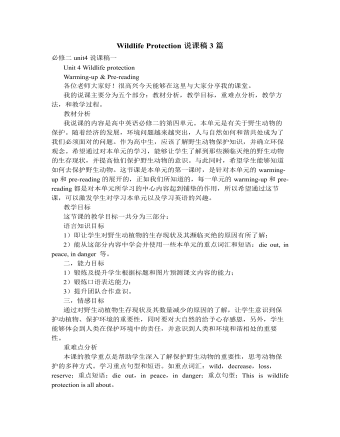
人教版高中英语必修2Wildlife Protection说课稿3篇
When it comes to the students’ studying methods, I'd like to introduce my Ss first. The Ss have a good command of basic language points. They’re interested in learning English, and they take an active part in English class, so they will have fun in autonomous, cooperative and inquiry learning. I will just serve as a guide, showing them the way to explore how to make more progress in their English learning.Now it’s time for the most important stage of this lesson. My teaching procedures are arranged as follows:Step1.Leading-in (3 minute)Play a video of a wide variety of wildlife to introduce my topic. Step2. Speaking (12 minutes)We will use our textbook Page25. Let the Ss fast read the short paragraph to warm up. Ask them to talk about the report on some endangered wildlife in China with the dialogue patterns on the screen. Lastly, I will invite some groups to demonstrate their dialogues about saving wildlife in China.Step3.English play (3 minutes)Watch another video in praise of their excellent performance just now. It’s about Jack Chen’s(成龙)and Yang Ziqiong’s wildlife protection.Step4. Listening (twice 13 minutes)This time, I’ll ask the Ss to fill in the blanks of the monologue of the 2 movie stars above. Step5.Discussion (3 minutes)Which would you like to choose to wear, clothes made of cotton, artificial leather or animal skins? Why ?Step6. Summary (3 minutes)1. If there were no wildlife, there wouldn’t exist human beings. If the buying stops, the killing can, too.2. Animals are our friends. To love animals is to love ourselves. Stop hunting, killing and destroying wildlife.3. Let’s live in harmony with all the living things in the world. Step7. Music appreciation (3 minutes)Let the Ss appreciate the song Earth Song by Michael Jackson. Last but not the least, I will show you my blackboard design.
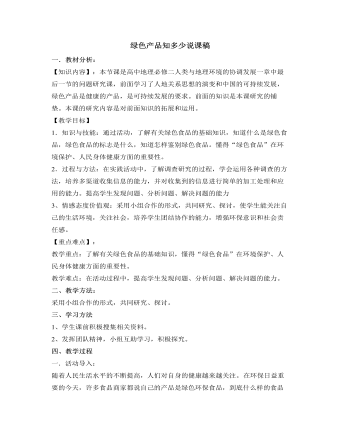
人教版高中地理必修2绿色产品知多少说课稿
各小组派代表汇报。4、教师提出问题组织学生讨论:⑴要想了解更多的绿色食品,了解绿色食品的销售情况,我们应该怎么做?⑵要想了解广大消费者对绿色食品的态度,食用绿色食品的意义,是否懂得辨认绿色食品,以及什么样的人群对此知识最缺乏等,我们应该怎么做?组织学生汇报交流。5、做个“绿色食品”广告设计师。为你喜欢的绿色食品设计广告语,每组推荐一个。6、让学生了解绿色食品认证程序。7、绿色食品打“假”队员在行动。8、向学生介绍生态绿色食品基地。三、活动总结:通过研究、探讨,了解学生对绿色食品的态度。提问:民以食为天,吃,是一个大问题,如果你的爸爸妈妈让你到超市买牛奶、方便面等,你会选择什么样的食品?为什么?希望通过今天的学习,同学们能够做到绿色消费,也希望你们向自己的家人、向周围的了解学生对“无公害食品”、“有机食品”与“绿色食品”的认识。
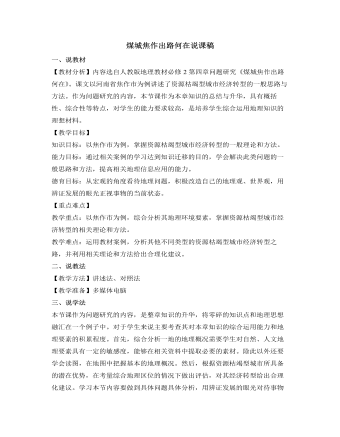
人教版高中地理必修2煤城焦作出路何在说课稿
分析过焦作市的地理概况和产业优势后,就需要针对由于资源枯竭所带来的问题提出合理化的建议。既然是谈经济转型,就应该将话题的范围明确在这一领域内。通过材料3的相关内容,我们了解到焦作市需要在产业结构调整、培育新的优势产业、增强综合竞争力等三个整改方针上下功夫。因而引导学生针对优势与不足提出建议,以三个整改方针为基准,衡量建议的可行性是锻炼学生解决此类问题的有效途径。在此我将教会学生的是解决问题方法而非案例的内容,正所谓“授之以鱼,不如授之以渔”。接下来针对学生的建议和教材资料分析所罗列的10点整改思路,由学生自由发言提出看法,通过教师的指导和学生的讨论,进而确定经济转型建议的具体方案。最后注意将建议与产业优势相对照,看建议是否都是围绕着产业优势而提出的,这样做会加深学生的印象,通过建议和优势的对应关系,将不难找出此类问题的解题思路。
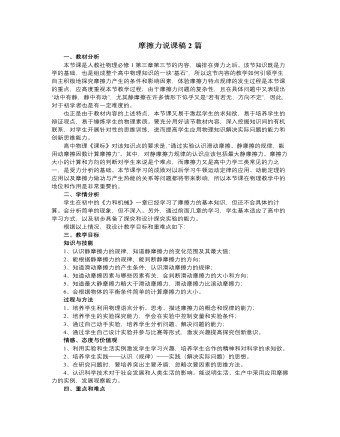
人教版新课标高中物理必修1摩擦力说课稿2篇
本节课是人教社物理必修1第三章第三节的内容,编排在弹力之后。该节知识既是力学的基础,也是组成整个高中物理知识的一块“基石”,所以这节内容的教学如何引领学生自主积极地探究摩擦力产生的条件和影响因素,体验摩擦力特点规律的发生过程是本节课的重点,应高度重视本节教学过程;由于摩擦力问题的复杂性,且在具体问题中又表现出“动中有静,静中有动”,尤其静摩擦在许多情形下似乎又是“若有若无,方向不定”,因此,对于初学者也是有一定难度的。也正是由于教材内容的上述特点,本节课又易于激起学生的求知欲,易于培养学生的辩证观点,易于锤炼学生的物理素质。要充分用好该节教材内容,深入挖掘知识间的有机联系,对学生开展针对性的思维训练,进而提高学生应用物理知识解决实际问题的能力和创新思维能力。高中物理《课标》对该知识点的要求是,“通过实验认识滑动摩擦、静摩擦的规律,能用动摩擦因数计算摩擦力”。其中,对静摩擦力规律的认识应该包括最大静摩擦力。
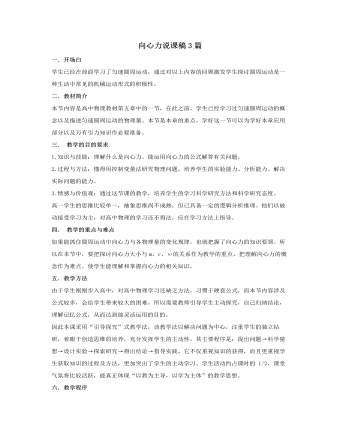
人教版新课标高中物理必修2向心力说课稿3篇
通过这个示例呢,我们可以得到解决向心力问题的一般的步骤,确定对象,找出轨迹,找出圆心,然后进行受力分析,让同学们参考这样的步骤,逐步的解决圆周运动的问题,对于变速圆周运动,我通过链球运动进行引入,这里是一个链球运动的视频,在同学们观看视频之前,我给同学们提出问题,链球收到绳子的拉力,做的是匀速圆周运动吗? 然后再课堂上我们再做一个小实验, 我们可以通过改变拉线的方式来调节小球的速度大小吗? 那么对小球,做加速圆周运动,进行受力分析,我们可以看到,小球做加速运动时,他所受到的力,并不是严格通过轨迹的圆心,在进行分析的时候,特别强调,小桶所受力的切线方向分力,和法线方向分力,切线方向分力,改变小球运动速度大小,法线方向分力,改变了小球运动的方向,法线方向的分力,在这里就是向心力,产生了向心加速度,通过这样一个例子进行分析,同学们是比较容易理解的,